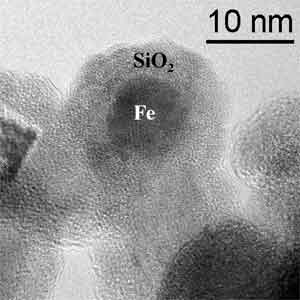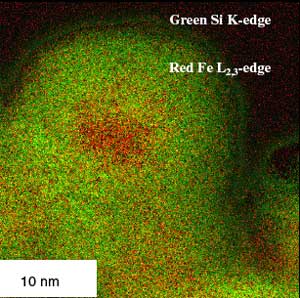| Posted: Feb 24, 2006 | |
Nanoscale magnetic materials are a key focus in developing biomedical applications |
|
| (Nanowerk News) Spanish researchers developed a simple and inexpensive way to produce well-coated iron nanoparticles. The particles thus obtained present a much stronger magnetic response than any composite material produced up to now involving magnetic nanoparticles encapsulated in inorganic matrices, and the rich chemistry and easy functionalization of the silica outer surface make them promising materials for their application as magnetic carriers. | |
| Nanotechnology has developed to a stage that makes it possible to produce, characterise and specifically tailor the functional properties of magnetic nanoparticles for biomedical applications. These range from magnetic sorting used to recognize cells, as contrast agents for MRI imaging, as a target mechanism, and as drug or gene delivery agents. | |
| For magnetic nanoparticles to be used in in-vivo applications, very low values of applied magnetic field are desirable. Therefore the suitable materials are those with high magnetisation at the operation at room temperature. | |
| Magnetic nanoparticles commonly comprise of a magnetic core, usually iron and its oxides, encapsuled with a biocompatible coating such as an organic polymer or an inorganic shell that renders them biologically inert (research also continues into alternative magnetic particles such as cobalt or nickel, however these are toxic and susceptible to oxidation). The utilisation of magnetic iron oxide nanoparticles has the added advantage that the body is designed to process excess iron. | |
| In all biomedical applications the coating of the particles is a very important issue. It helps to make the particles biocompatible, preventing their aggregation and the degradation of the metallic core, and reducing the extent of clearance by the reticuloendothelial system. Moreover, the outer coating surface of the particles can be functionalized to allow the binding of antibodies, proteins, medical drugs or other biomolecules to the system. | |
 |
|
| Transmission electron micrographs of silica-coated iron nanoparticles. (Source: University of Zaragoza) | |
| In spite of encouraging progress in recent years, the development of magnetic nanoparticles that can be used as drug delivery vectors remains a significant challenge for materials scientists. | |
| One researcher active in this area, Jesús Santamaría from the Institute of Nanoscience of Aragón at the University of Zaragoza in Spain, explained to Nanowerk that any proposal for a drug delivery system must confront at least two yet-unsolved challenges: | |
| "First of all, target selectivity is necessary, meaning that the drug must be released preferentially to the target organ or cells, minimizing damage to healthy tissue." | |
| "Second, the rate of drug delivery in the proximity of the target organ or cells must be controllable. In addition, a common limitation to all methods is of course the need to achieve a sufficient degree of biocompatibility." | |
| What makes iron-based nanoparticles so interesting are their characteristics, that allow researchers to address these hurdles. Says Santamaría: "With iron-based magnetic nanoparticles one should be able to: | |
| 1) Direct the particles to the vicinity of the target organ, using either external or internal (i.e., implanted permanent magnets) fields. | |
| 2) "See" the particles, (e.g., by MRI), and follow their fate within the body. | |
| 3) Accelerate, if needed, the rate of release once the target organ has been reached, using magnetic field heating." | |
| In a recent paper, Santamaría and his colleagues describe a new one-step method to prepare iron nanoparticles surrounded by thin silica coatings. The researchers synthesized their nanoparticles by means of the arc-discharge method, which is a novel approach to the synthesis of these materials. | |
 |
|
| EFTEM (Energy Filtered Transmission Electron Microscopy) of the fabricated particles shows an iron-rich core and a silica-rich shell. (Source: University of Zaragoza) | |
| The silica outer layer not only provides a good degree of biocompatibility, but also a high specific surface area (which can be used as carrier of adsorbed drugs) and an external surface whose rich chemistry allows easy functionalization by suitable biomolecules. Also, controlling the thickness and pore-size distribution of the silica coating provides a direct method to tailor the rate and duration of drug release. In spite of the silica coating, the magnetic properties of the particles are still remarkable, with magnetic moments exceeding 160 emu/g. | |
| The paper, titled "Highly magnetic silica-coated iron nanoparticles prepared by the arc-discharge method" was published in the Feb. 7, 2006 online edition of Nanotechnology. | |
 By
Michael
Berger
– Michael is author of three books by the Royal Society of Chemistry:
Nano-Society: Pushing the Boundaries of Technology,
Nanotechnology: The Future is Tiny, and
Nanoengineering: The Skills and Tools Making Technology Invisible
Copyright ©
Nanowerk LLC
By
Michael
Berger
– Michael is author of three books by the Royal Society of Chemistry:
Nano-Society: Pushing the Boundaries of Technology,
Nanotechnology: The Future is Tiny, and
Nanoengineering: The Skills and Tools Making Technology Invisible
Copyright ©
Nanowerk LLC
|
Become a Spotlight guest author! Join our large and growing group of guest contributors. Have you just published a scientific paper or have other exciting developments to share with the nanotechnology community? Here is how to publish on nanowerk.com.
